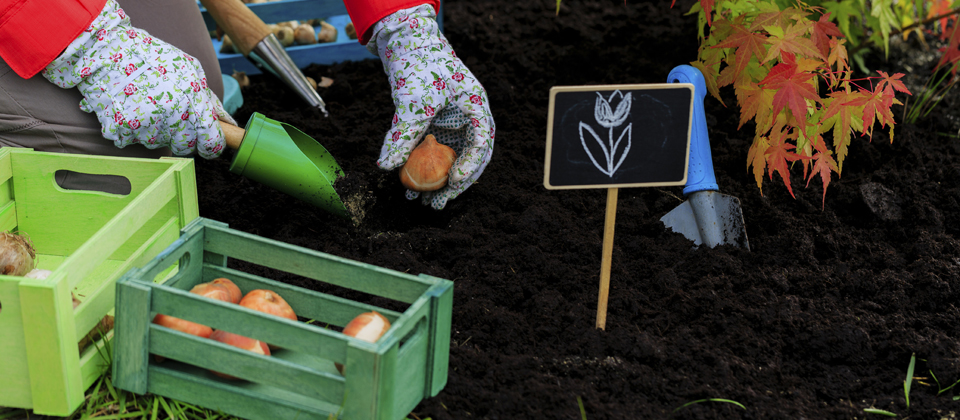blog, News and Tips
Planting Spring Flowering Bulbs – FAQ
New to planting bulbs? Need helpful guidance and tips to ensure beautiful blooms? Select the Spring Planting Bulbs or Fall Planting Bulbs link below to see a list of frequently asked questions and answers.

What are fall planting bulbs?
Fall planting bulbs are plant species that need to be planted in the ground in the fall before the first hard frost. Bulbs such as tulips, daffodils, narcissus, hyacinths, iris, allium, fritillaria, and scilla require a cold period in order to form roots, and based on lighting and warmth conditions will bloom in the spring.


What should I look for when buying fall planting bulbs?
Look for bulbs that are firm. Bulbs that are mushy usually have not been kept in a cool dry place and will rot, and therefore, not flower. As a consumer it is important to understand bulb sizing. While bigger is not necessarily better, it is important to understand what is and what is not a consumer value. For example, top size tulip bulbs have a circumference of 12 centimeters or more. If you are trying to showcase a set of 10 tulips in your yard, look for top size bulbs. On the other hand, if you would like to plant a large bed of tulips for cut flowers or just to display a carpet of spring color, smaller tulips with a minimum circumference of 10 centimeters are perfectly acceptable. The bigger the bulb, the more blooms you get and the larger they will be. Bulbs will grow larger in the ground after blooming.


How does bulb sizing work and what should I look for?
Since bulbs come from Holland, bulb sizes within the industry are usually given in centimeters and are usually labeled as such by the “cm” notation to indicate the circumference of a bulb (note there are 2.54 centimeters in an inch.) To measure a bulb, wrap a tape measure around widest part of the bulb and measure. The following chart provides a guideline as to what are the minimum and maximum sizes of fall planting bulb varieties.
| Variety |
Top size |
Minimum acceptable size |
Notes |
||
|
In centimeters |
In inches |
In centimeters |
In inches |
||
| Tulips |
12/+ cm |
4.72 |
10 cm |
3.94 |
|
| Narcissus and Daffodils |
16/+ cm |
6.3 |
12 cm |
4.72 |
|
| Hyacinths |
19/+ cm |
7.48 |
14 cm |
5.51 |
Top size hyacinths are usually reserved for indoor forcing. In the garden look for hyacinths size 15/16 cm. Larger hyacinths have a tendency to fall over from the weight of the flower. |
| Large Flowering Crocus |
9/+ cm |
3.54 |
7 cm |
2.76 |
|
| Specie or Snow Crocus |
5/+ cm |
1.97 |
4 cm |
1.57 |
|
| Dutch Iris |
9 cm |
3.54 |
7 cm |
2.76 |
|
| Specie Iris |
6 cm |
2.36 |
4 cm |
1.57 |
|
| Large Allium |
20/+ cm |
7.87 |
19 cm |
7.48 |
Includes following varieties: Giganteum, Lucy Ball, Stipitatum, Globe Master |
| Medium Allium |
14/+ cm |
5.51 |
12 cm |
4.72 |
Include following varieties: Aflatuense, Christophii, Karataviense, Rosenbachianum, Schubertii, Ivory Queen |
| Small Allium |
4 to 6 cm |
1.57 – 2.36 |
4 cm |
1.57 |
Includes following varieties: Moly, Ostrowskianum, Neapolitanum, Sphaerocephalon |
| Fritillaria Imperial |
24/+ cm |
9.45 |
22 cm |
8.66 |
|
| Amaryllis |
34/+ cm |
13.39 |
24 cm |
9.45 |
|
| Jumbo Amaryllis |
42/+ cm |
16.54 |
n/a |
n/a |
Only a few varieties of Amaryllis grow larger than 34 cm |
| Paperwhite Narcissus |
17/+ cm |
6.69 |
14 cm |
5.51 |
Ask your local retailer for Jumbo paperwhites. |
| Oriental Lilies |
18 cm |
7.09 |
16 |
6.30 |
|
| Asiatic Lilies |
14/+ cm |
5.51 |
12 cm |
4.72 |
|


When should I plant my fall bulbs?
Fall bulbs must be planted in the fall before the first hard frost. It is best to wait until the outside temperature does not reach 65 degrees anymore. If there is a hard frost in the first couple weeks after planting, mulch your beds and remove in the spring. Light morning frosts will not hurt the bulbs.


Oops! I forgot to plant my bulbs this fall. What should I do?
Fall bulbs really need to be planted within 6 months of purchase. Bulbs are dormant, but still very much a living product that need the right balance of water and soil. Leaving bulbs out of the ground for too long will cause them to lose their hydration and die. If your ground is frozen in December for example, try to wait for a thaw or break in the weather and plant them a little deeper than normal. If this seems an unlikely scenario, plant your bulbs in pots, place them in a cool (not freezing) dark place and water sparingly throughout the winter. When the ground thaws in the spring, you can place the pots in the ground or on your patio. As a last resort you can plant the bulbs in the spring when the ground thaws, but do not expect many flowers that spring. Feed with bulb care fertilizer and you should have better results next spring.


It is not even spring, and my bulbs are coming up, what should I do?
There is nothing you can do, if the weather is unusually warm some bulbs will be confused and start to sprout. The good news is that this means that your bulbs have a good root foundation and no snow to shovel! Most bulbs are resilient and will bloom again in the spring.


Why can’t I plant fall bulbs in the spring?
Bulbs require a minimum cold period of 6 weeks to form roots. If you plant bulbs in the spring they will not have sufficient cold weeks to grow their roots. It also means that the bulbs have been dormant for over 9 months. This long period of dormancy will also affect bulb performance.


What can I do to prevent deer, rodents, rabbits and other animals from eating my bulbs and flowers?
The best remedy for preventing animals from eating your bulbs is to plant bulbs they do not like to eat. While you can spray them with soap, pepper, or a chemical, this tends to wash off after the first rainfall and can be time consuming. Here is a list of bulbs that deer, rabbits, and other rodents do not like to eat:
- Daffodils
- Narcissus
- Hyacinths
- Allium (all types)
- Fritillaria
- Fall Flowering Crocus
- Iris (all types)
- Anemones (all types)
- Scilla (all types)
- Snowdrops
- Eranthus
- Chinadoxa
- Muscari Grape Hyacinths


What is a hardiness zone?
The US Department of Agriculture and the US National Arboretum have prepared a map representing winter hardiness for certain types of plant material. Most fall planting bulbs are considered hardy and will survive the most severe winters including, tulips, daffodils, narcissus, hyacinths, crocus, scilla, fritillaria, iris, snowdrops, muscari, eranthus, and chinodoxa. However, if you do live in zones 1 through 4, or if you live in the mountains, additional mulch to protect against severe freezing temperatures (20 degrees below zero) is recommended.
For more details about your specific region please see the USDA Hardiness Zone Map.


I live in a warm climate; which bulbs are best for my area?
The following bulbs DO NOT need to be cooled: Narcissus, Dutch Iris, Anemones, Ranunculus, Freesia, Ixia, Sparaxis, and Amaryllis.


I live in a severely cold climate; are you sure my bulbs will make it through the winter?
Bulbs are extremely hardy as many are indigenous to Europe or Central Asia which are equally cold climates. The following bulbs are very hardy: tulips, daffodils, narcissus, crocus, hyacinth, scilla, iris, and fritillaria. In areas of the country where the average temperature regularly drops below zero we recommend adding a foot of mulch as protection which can be removed in the spring time when the danger of severe freezing temperatures has passed. Otherwise, rest assured, occasional cold temperatures are good for bulbs.


What type of fertilizer should I use?
Fertilizer is not necessary, but for increased performance a small application of Bulb Booster or bone meal is acceptable. It is more important to make sure the pH level of your soil is correct.


What is the right pH level of soil for bulbs?
Having the right pH level in your soil is important to bring out the true flower color. The ideal pH level for bulbs is between 6 and 7. To check your pH level, bring a soil sample to your local garden center or purchase an inexpensive testing kit.


What do I do after my fall planting bulbs have bloomed in the spring?
Let the leaves die down naturally; do not cut them off or mow over them. After bulbs have bloomed it is important to let them rest because during this period, the bulb is gathering nutrients from the soil and growing so that it can bloom again next year.


How do I grow Tulips, Daffodils, or Crocus inside?
The term often used in the industry is “forcing.” However, not all varieties are suitable for indoor forcing, therefore, for best results, look on the packaging of the bulb or ask your local garden center which bulbs are most suitable for indoor forcing.
- Select a shallow 6″ ceramic pot, and fill the bottom with an inch of gravel. It may be necessary to place a shard of broken pottery or large rock over the hole in the bottom of the pot.
- Next, fill the pot with moist potting soil.
- Place your bulbs in the soil mix, leaving just the tips exposed. A good rule of thumb is 15 crocuses, 6 tulips, 6 daffodils, or 3 hyacinths per six inch pot. After you’ve finished planting the bulbs, place the pot in a cool place. A refrigerator works great for this. After the bulbs have been cooled for about six weeks, remove the pot. Place the pot in a sunny, warm location and keep the soil moist but not wet. In a few weeks the bulbs should start growing.


How do I grow Hyacinths inside?
Hyacinth bulbs require a dormancy period in order to flower when forced.
- Place them in a refrigerator for about six weeks before forcing. After the bulbs have been cooled sufficiently, place them into a special hyacinth vase. These can be found at your local garden center. Add water up to the neck of the vase. Place your hyacinth in the vase.
- It is important that the water level is kept just below the bulb itself. If the water is touching the bulb it will rot.
- After a few weeks, roots will start growing towards the water. Once the roots are well established the bulb will sprout, and shortly after that it will begin to flower.


How do I plant Amaryllis bulbs?
Potting Instructions
Place 2 inches of potting soil in the bottom of your pot. The Amaryllis bulb likes to sit with 1/3 of the bulb above the soil line so place bulb accordingly in your pot and gently pack the soil between the roots. There should be about 1 inch of soil between the bulb and the edge of the pot as they like a tight fit.
Watering Habits
Water once when you first pot up your Amaryllis bulb, then sparingly until the sprout is well out of the bulb. Then water regularly, and you will soon be rewarded with the most spectacular blooms, 4 to 6 per stalk and 2 – 3 stalks depending on the size bulb planted.
Aftercare
When blooms fade, cut off the tubular flower stem near the top of the bulb, leaving the foliage to continue growing. Water as usual and apply a water-soluble fertilizer every four weeks. Once the danger of frost is past, you may move your Amaryllis bulb outdoors to your garden where it can enjoy the summer sun. Be sure to continue your fertilizer program every four weeks as this is necessary for the next round of indoor forcing. In early autumn, bring your Amaryllis inside and allow it to completely dry out. Cut off the dry leaves and let it “rest” for 6 weeks. Now repot your Amaryllis in new soil and start the process all over again.


How do I grow Paperwhite Narcissus?
Paperwhites can be grown without going through a cold storage period. Simply fill a pot halfway with soil, set the bulb gently in the soil and pack more soil around the bulbs leaving the tips visible. Water the bulbs thoroughly, allowing time for the soil to absorb enough water so it is thoroughly soaked. Place anywhere in the house and watch them develop. Place them preferably in a window sill where there is plenty of light. If you place your Paperwhites for 3 to 4 weeks in a cooler place (45 – 55 degrees F.) directly after planting, they generally stay shorter which prevents them from falling over when in full bloom.



